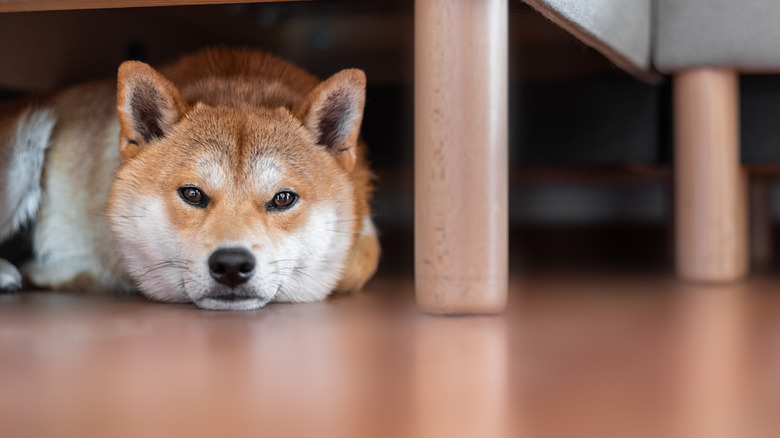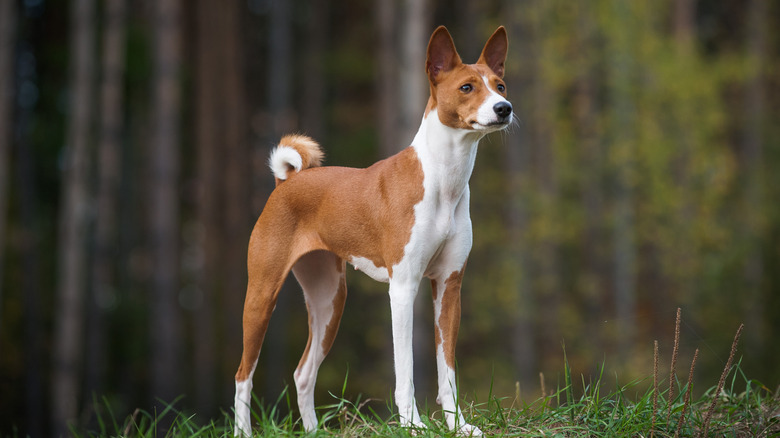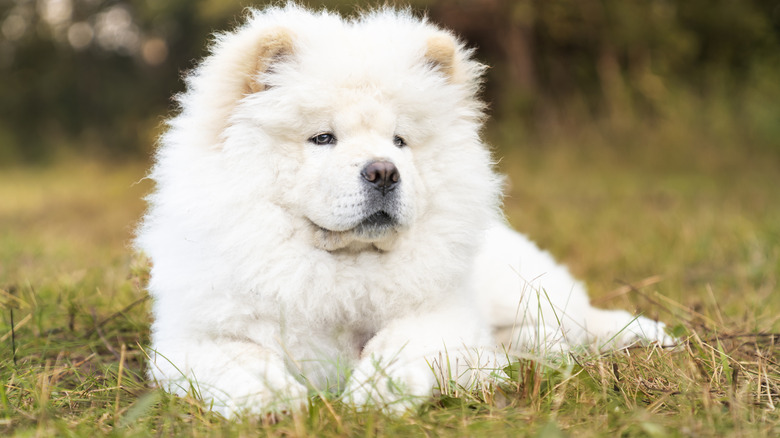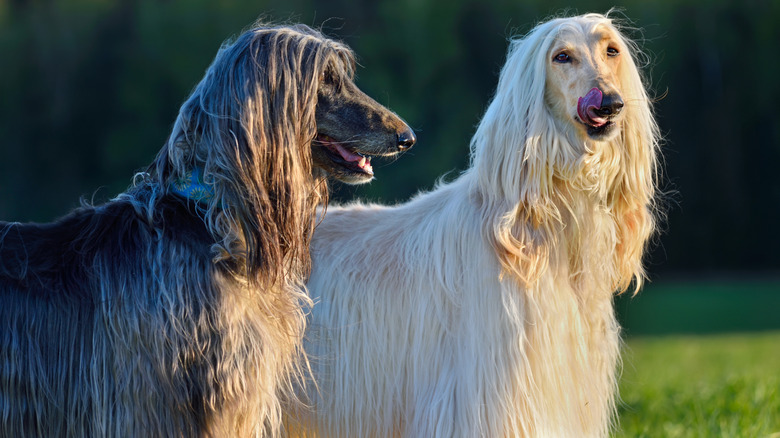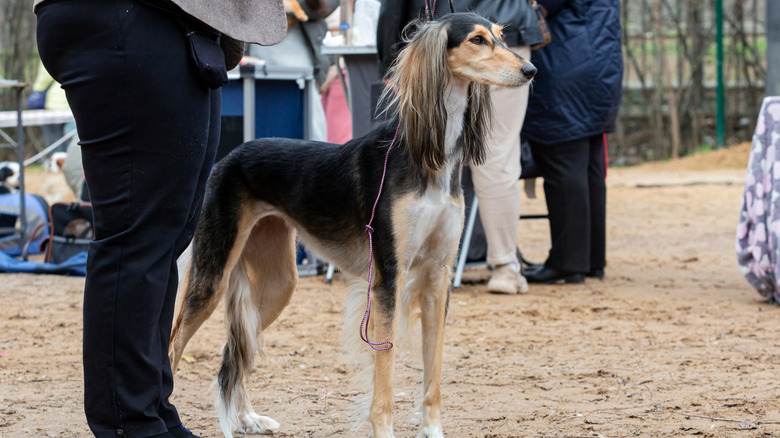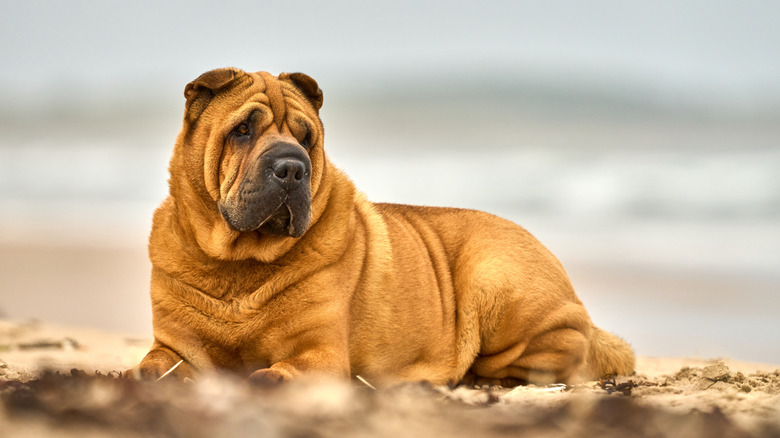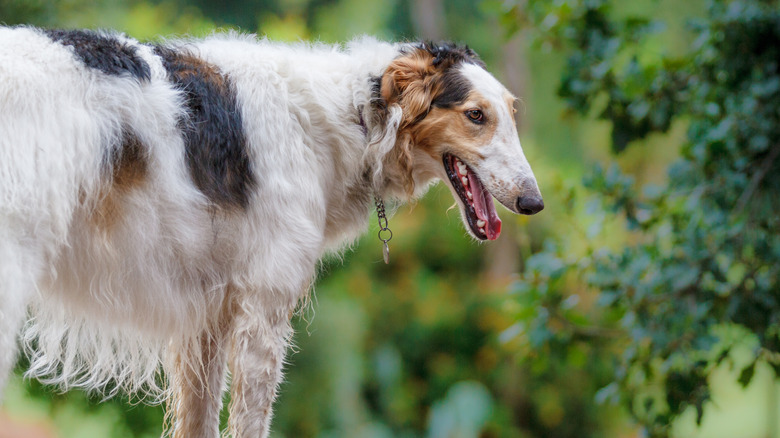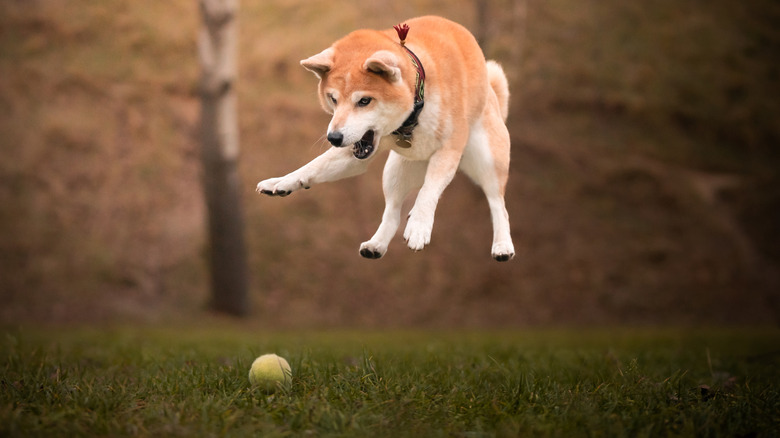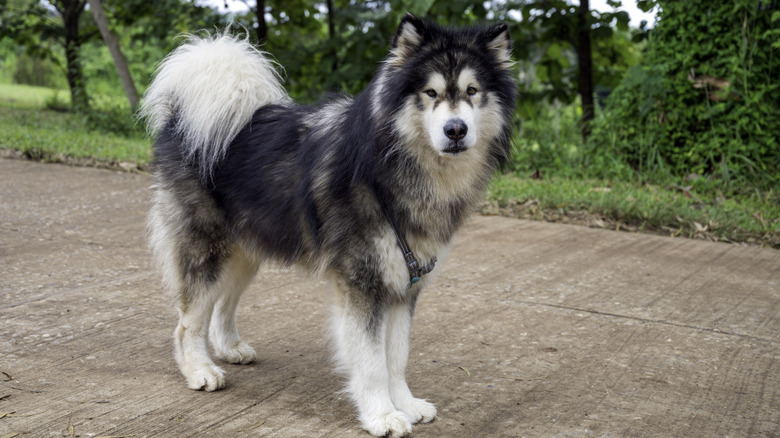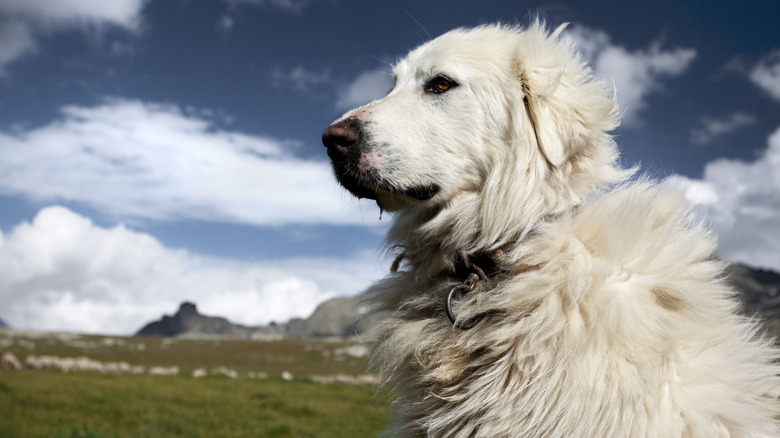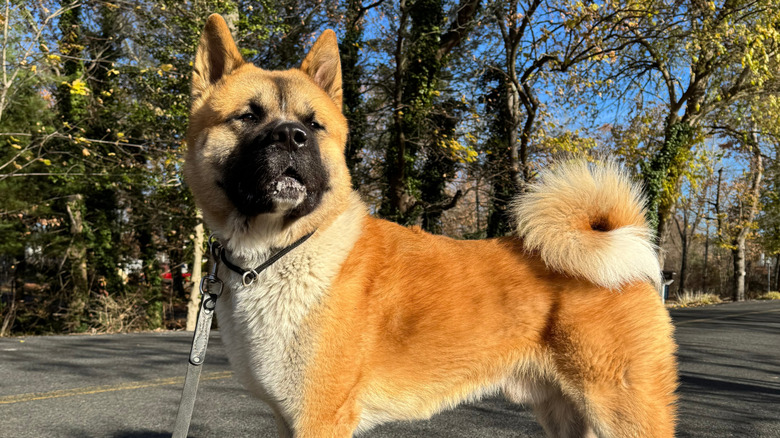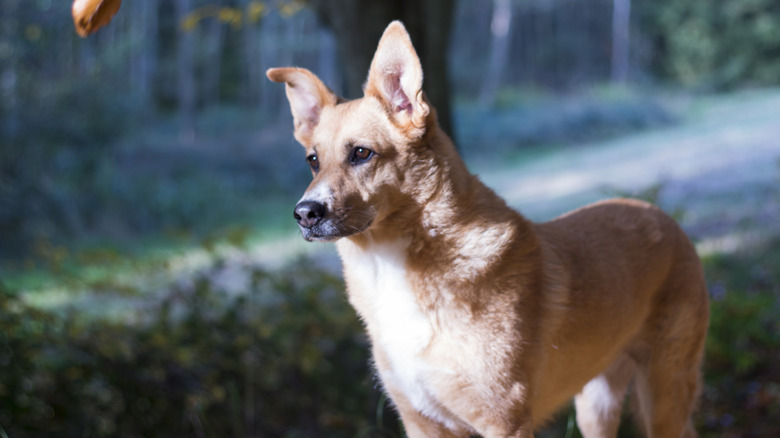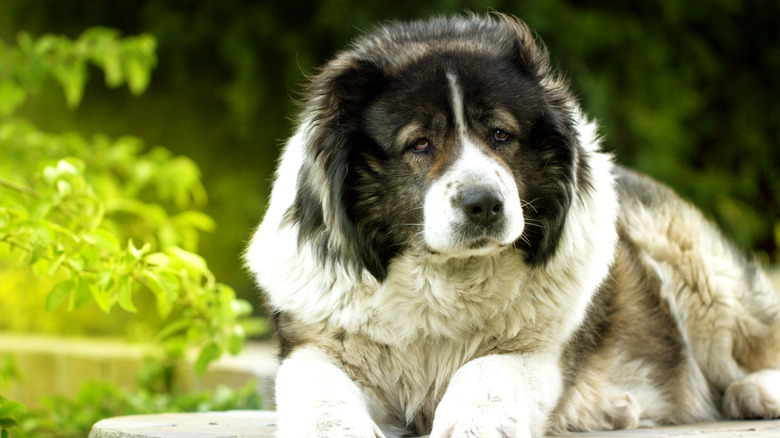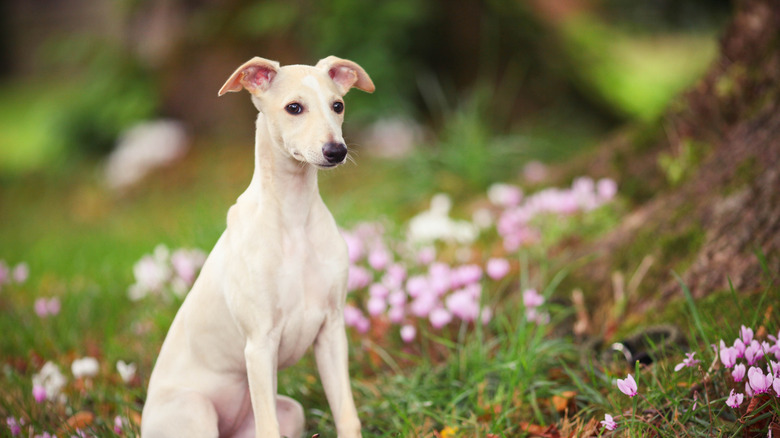13 Dog Breeds That Like Their Personal Space
Dogs are often celebrated as devoted companions that thrive off constant attention and praise. But believe it or not, some breeds are naturally more introverted than others. For example, sighthounds (dogs that were bred to hunt separately from humans) are often described as "cat-like". Rather than spend hours being the life of the party, they're content to lie in a corner and have people come to them — not the other way around. These breeds include Afghan hounds, whippets, and salukis.
Other breeds aren't "reserved" per se, but instead only allow a few people into their inner circle. This behavior is commonly seen in dogs that were bred to guard property. There's little room for friends when the home's security is at stake! Chow chows are a perfect example of this. While they offer unwavering devotion to their loved ones, they regard strangers with suspicion until they prove themselves trustworthy. Approach a chow chow too quickly, and you may find yourself dealing with a growling, snarling poofball!
Note that while some dog breeds are more inclined to certain behaviors than others, each dog is an individual. A canine's unique disposition also plays a role in its temperament and sociability. That said, dogs of certain breeds tend to be more aloof, independent, or in need of personal space than others.
1. Basenjis: Africa's barkless, reserved dog breed
Basenjis are small hounds that originated thousands of years ago in ancient Egypt. Known for being active, inquisitive, and energetic, they're not the first dog that people would associate with requiring much personal space. Yet, while the basenji thrives on constant stimulation, it's perfectly content with entertaining itself. Most often, this leads to excessive digging, patrolling, and chewing. They love their owners but don't languish in their absence.
It's critical that owners socialize their basenjis from a young age to avoid problems with reactivity and aggression. These small dogs may snap or growl when faced with other dogs, young children, or strangers, which can escalate into conflict. Positive reinforcement-based training and confidence-building exercises can go a long way, but it's important to note that by nature, most basenjis aren't social butterflies. A well-socialized basenji will likely ignore other dogs and people in public rather than bound up to them eagerly.
You may enjoy owning a basenji if you're looking for a small-sized canine that loves physical activity. They make ideal additions for apartment-dwellers because this is the only dog breed that doesn't bark! While they can make a sound akin to yodeling, basenjis aren't excessively vocal.
2. The chow chow is a one-person breed
Some dogs, such as the chow chow, have exclusive social circles that only include a few family members. Don't worry; this reservation isn't personal. It's all in the name of security. Chow chows were bred in ancient China as both companions and guard dogs for the wealthy elite. As a result, these medium-to-large-sized canines will spend hours patrolling a home's perimeter and sniffing for signs of trouble. Upon recognizing a perceived threat, they'll issue a low, grumbling bark to alert their owners.
Chow chows don't take kindly to strangers and may snap if they're approached too suddenly. It may take several positive interactions for a chow chow to begrudgingly accept a new person, and even then, they'll likely refrain from initiating contact. Even with people they know, chow chows are the type of dog to follow someone passively from room to room instead of demanding cuddles. Still, if you're lucky enough to earn a chow chow's trust, you'll find a devoted companion that is dedicated to keeping you safe –- even if it's just from the pizza delivery guy. Cat-like and quiet, chow chows are prized for their regal nature and aristocratic regard.
3. Afghan hounds have an independent streak
A 2023 study published in Frontiers in Psychology highlights the powerful social bonds that can form between humans and dogs, with some canines viewing their owners as parents or parent-adjacent. In turn, this leads to a powerful connection that lends itself to intimacy, trust, and love. The key term here is "some dogs". Certain breeds, like the elegant, dignified Afghan hound, are common outliers. Afghan hounds tend to be incredibly self-willed and independent, which can make training difficult. These sighthounds view commands as suggestions, and this reluctance to obey has earned Afghans a reputation as being the least intelligent dog breed, according to Dr. Stanley Coren's landmark book, "The Intelligence of Dogs".
There's a reason why Afghan hounds are renowned for being dogs that need their personal space. For starters, they were bred to be companions to aristocrats, royals, and tribal leaders in Asia thousands of years ago. Sure-footed and confident, these dogs were also used on hunting expeditions, where they commonly acted without much human direction. This independence has carried over to their lives as household pets.
4. Salukis are reserved ancient sighthounds
At play, you might never guess that the agile, nimble-footed Saluki needs some personal space. Yet, make no mistake: while these dogs love nothing more than to chase small animals, at home, they're not too keen on having others in their business. They love to play, but like a timid deer, if you approach a Saluki too quickly, you'll scare it off! Salukis are very devoted to their owners, but strangers may need a few sniffing sessions before they're considered friends.
Salukis need their personal space for the same reason many other sighthounds do: these dogs were bred thousands of years ago to work independently of human instruction. This dog's reserved disposition is even part of the breed standard, with the AKC sharing: "The expression should be dignified and gentle with deep, faithful, far-seeing eyes."
If you want to befriend a Saluki, take things slowly. Start with offering high-value treats, such as chicken or turkey, then praising the dog for each successful interaction. Keep petting sessions to a minimum, and be sure to understand the signs of stress in dogs, such as lip-licking or refusing to meet your gaze. Salukis generally aren't aggressive and likely won't snap at you, but being too forward can be off-putting to them. Let them come to you!
5. Chinese shar pei are independent by nature
Known for their wrinkly jowls and hippopotamus-shaped heads, the Chinese shar pei is steadfastly loyal to its family members, but extremely standoffish with strangers. Aloof and independent, these dogs need a firm hand from puppyhood to avoid dominant behaviors, which can complicate relations in multi-dog households. While the AKC rates shar pei a 3 out of 5 on the trainability scale, these dogs are not recommended for first-time dog owners because of their stubborn nature.
The Chinese shar pei is a watchdog at heart, ever-alert and remaining on the lookout for intruders. When someone enters its personal space, a shar pei will have no problem voicing its displeasure, whether through snarling, growling, or barking. This breed has an impressive bite force, ranging from 120 to 140 pounds per square inch (PSI). That might not be the strongest bite in the dog world, but it could certainly inflict a lot of damage. Early socialization, training, and confidence-building exercises are key to having a well-mannered shar pei.
6. Borzoi were bred with elegance in mind
According to the AKC, borzoi, also known as the Russian wolfhound, are bred with "unmistakable elegance" that comes with a fierce independent streak. This can make training a challenge, because like the Afghan hound, borzoi view commands as suggestions. It could take several training sessions for the stubborn borzoi to master simple tricks, like "sit" and "come here". They're not dumb by any means; in fact, borzoi are known for their intelligence. They're just not overly social, and this doesn't lend itself to mastery with training.
Is this rare breed you've likely never heard of recommended for families with small children? The answer is "it depends." Borzoi do not tolerate rough handling of any kind. Even having its tail tugged could result in a days-long huff. Consistency and patience are critical to earning a borzoi's trust and being admitted into its inner circle. Positive reinforcement-based training, which involves creating a positive association with a desired behavior, could earn you a borzoi's seldom-given affection.
7. Shiba inus are loving yet independent
Shiba inus are very loving family members, but their tenacious nature makes them quick to snap at other dogs. It's not easy having big dog energy in a small body, and that's certainly true for this breed that stands just 16.5 inches at the withers! This fox-like dog is theorized to have originated in 300 B.C. Japan, where it hunted in the rugged mountain landscapes.
To succeed in capturing birds, rodents, and small boar, the shiba inu needed to be fierce. Even as the breed transitioned from the hunting arena to the domestic sphere, it maintained traces of its independent and territorial instincts. Shiba inus aren't an overly clingy breed, and while they can cohabitate with other dogs, they generally like their own space.
Still, this reserved nature does not deter many people from getting these dogs. Thanks to memes and popular internet culture, shiba inus have seen a boost in popularity over the past few years. They've earned a reputation of being cat-like dogs that are selective with their affection. You can build trust with a shiba inu by respecting its boundaries and letting it initiate contact on its own terms.
8. Alaskan Malamutes need early socialization to thrive
Alaskan Malamutes, a dog breed that thrives in cold weather, are pack animals through and through. As one of the oldest sled dog breeds, they were bred to pull cargo long distances and work together to meet a common goal. However, despite this closeness with other dogs, the Alaskan Malamute is independent and self-willed. Stubborn almost to a fault, these dogs need socialization from an early age to prevent problems stemming from reactivity and resource-guarding. The AKC notes that without a firm hand, Malamutes sometimes end up owning their owners, and they have no issue calling the shots!
Malamutes are not usually aggressive; they do moderately well with young children and other dogs. But if not properly socialized, they can snap at strangers, bark at neighbors, and in general feel wary of newcomers. To respect a malamute's boundaries and instill trust, familiarize yourself with the signs of discomfort in dogs. A malamute in need of personal space will avert its gaze, lick its lips, and pull its ears back. It may also have a stiff body and raise its hackles.
It could take multiple interactions to ingratiate yourself with a malamute that has trust issues. Approach each interaction with treats, words of affection, and slow movements. Soon, you'll find yourself covered in dog hair from all the snuggle sessions!
9. Great Pyrenees were bred to be self-reliant
When thinking of dogs with a calm, zen-like aura, the Great Pyrenees may be one of the first breeds that comes to mind. This immensely powerful canine was bred to guard livestock in the rugged mountainous region between France and Spain. While vicious to would-be predators, the Great Pyrenees often viewed sheep, goats, and other farm animals as members of its extended family. Its puppies are sometimes raised alongside lambs, creating a loyal bond from the very beginning of their lives.
In the domestic sphere, the Great Pyrenees doesn't need its personal space out of malice or a desire to be left alone. It just exudes a coolness that comes with being self-reliant while guarding sheep. These dogs often worked without much interaction with humans, and by relying on their keen nature, they were able to keep flocks safe. The good news is that while a Great Pyrenees might not demand attention, it makes a beloved pet for single-person households and families with kids alike. Expect them to offer affection on their own terms, whether that's through demanding the occasional snuggle or begging for a piece of your sandwich.
10. Akitas have a low tolerance threshold for other dogs
There's no denying that the Akita, one of Japan's monument dog breeds, is a majestic canine. Fiercely devoted to its small circle of trusted family members, it's hardwired to view strangers and even other dogs as potential threats. For a pup that can weigh more than 100 pounds, its bite is certainly worse than its bark. On a scale of 1 to 5, the AKC notes that this dog ranks a 1 in terms of compatibility with other breeds. They're not recommended for multi-dog households or inexperienced owners.
Training and socialization must begin from the moment you welcome an Akita into your home. This involves setting firm boundaries and remaining consistent with various aspects of training, including conduct on walks, with strangers, and in the car. An Akita in training will constantly look for ways to push the envelope and get its way. You must remain firm in your convictions and work to establish a mutual relationship based on trust. Even then, you must ensure that your dog remains under your control and on a leash; there's no amount of socialization that will turn this steadfast breed into a social butterfly.
11. Carolina dogs must warm up to strangers
Most people don't associate the United States with having packs of wild dogs. But for some parts of the South and New England, seeing limber, jackal-like canines is a matter of life. Meet the Carolina dog, a semi-feral dog that's been found in Arizona, Georgia, and true to its name, South Carolina. They've even been spotted in Ohio, and Pennsylvania. That's a pretty wide range!
Unlike dogs that were bred for a specific purpose (such as border collies that were bred for herding sheep), these pups joined Paleo-Indians who made their way from Asia to North America thousands of years ago. Because Carolina dogs never worked closely with people, they've become suspicious of humans over the years. Generally, they only initiate contact when there's food involved or a mutually beneficial purpose. Domesticated Carolina dogs are affectionate with people who have gained their trust but think twice about letting others into the fold. However, they're open to making new friendships in safe, supportive settings.
12. The Caucasian shepherd dog: a serious guardian breed
"Fearless. Bold. Kind." These are the three adjectives that the AKC uses to describe the Caucasian shepherd dog, a 170-pound canine bred for its guarding abilities. Similar to the Great Pyrenees, Caucasian shepherd dogs were given the all-important task of keeping sheep safe from predators. In turn, this resulted in a confident, headstrong pooch with one goal: protecting its family.
When entering these dogs' domains, remember: they're more focused on guarding their loved ones than making new friends. Being mindful of your interactions with the owners of Caucasian shepherd dogs can go a long way. For instance, don't go in for a hug immediately after walking through the door –– a Caucasian shepherd dog may see this sudden movement as a threat. Refrain from speaking too loudly, and let the dog approach you rather than the other way around. Playing hard to get can assure the canine that you're only there for a friendly visit.
13. Whippets are fragile-bodied and cautious
Whippets are one of the fastest dog breeds and can reach speeds of up to 35 miles an hour. On the racetrack, these sleek sighthounds are all about being lightning-fast. At home, however, whippets are known for being a cat-like breed that wants nothing more than to hide under the bed. While affectionate with family members and tolerant of children and other dogs, whippets just aren't as social as other breeds. Like its laid-back sighthound counterparts, the whippet is often content to languish in a comfy crate or entertain itself with a chew toy.
If you push your way into a whippet's personal space, you'll be met with an avoidant, possibly anxious dog that doesn't meet your affections. Forcing a whippet to interact can even lead to prolonged stress, which can lower the immune system's response to infections and other diseases. As with everything in life, good things come to those who wait. Allowing a whippet to socialize on its own terms can build the foundation of a lifelong friendship.
